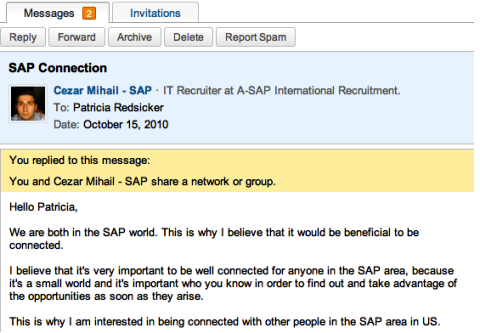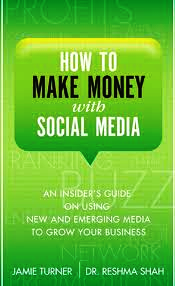 If you've ever asked the question, “Can I make money with social media?“, you might have heard a variety of answers such as, “No!”, “Maybe” or “It depends.”
If you've ever asked the question, “Can I make money with social media?“, you might have heard a variety of answers such as, “No!”, “Maybe” or “It depends.”
Rarely (if at all) have you heard the confident and unwavering response, “Yes, you can!”
In their book, How to Make Money with Social Media—An Insider's Guide on Using New and Emerging Media to Grow Your Business, Jamie Turner and Reshma Shah explain that there's a big difference between people who make money with social media and people who don't.
People who fail to make money with social media are those who never get their plan off the ground. They're the ones who (among other things):
- Don't know how to set up a landing page
- Don't remarket to “customer prospects”
- Don't know how to turn a social media campaign into a sales campaign
- Think they can do social media in ten minutes a day
- Sit on the sidelines
- And other faux pas
But people who make money are different. They set objectives, create a plan and execute the plan relentlessly.
And that's what this book is all about—The Plan. You've heard the old adage, “People don't plan to fail, they fail to plan.” Well it's true. And to make sure that it doesn't happen to you, the authors provide a thorough, “no-wiggle-room” roadmap that will put you on the path to social media success.
Here's what you should know about the book.
Authors' Purpose
The goal of the authors is to teach you some innovative ways of using social media, in order to generate real revenue and profits for you and your company.


In this book, Jamie Turner and Reshma Shah explain that by following “the roadmap,” you can use social media effectively to grow your business and make money as well.
So whether you're a small business owner, a regular business-to-business company or you run a huge division at a large global organization, the authors provide a practical plan to help you set up, launch and run a money-making social media campaign that will work specifically for you.
What to Expect
At 275 pages, this book is not meant to be read cover-to-cover in one sitting. It's much too extensive for that. Fortunately it's an easy read, has many interesting examples and lots of bullet points, and is therefore very skimmable.
The book starts with a brief history lesson on what advertising and marketing looked like before the Internet. It goes on to talk about how things have changed and where social media is going to take us in the future.
But the core of the book is literally a roadmap that starts by laying the groundwork for success, and on to measuring the only really important thing – money!
Get World-Class Marketing Training — All Year Long!
Are you facing doubt, uncertainty, or overwhelm? The Social Media Marketing Society can help.
Each month, you’ll receive training from trusted marketing experts, covering everything from AI to organic social marketing. When you join, you’ll also get immediate access to:
- A library of 100+ marketing trainings
- A community of like-minded marketers
- Monthly online community meetups
- Relevant news and trends updates
Also notable, toward the end of the book is a checklist of 59 things you need to do on your way to a successful social media campaign.
Some of the more interesting ideas that the authors introduce are:
- How to tell if your brand is a social media magnet
- How to use circular momentum to build your brand
- How to conduct a social media competitive assessment
- How to build new relationships with customers using augmented reality
- How to use different social media platforms to network, promote and share (they're not the same!): Facebook is like a pub, LinkedIn is like a trade show, Twitter is like a cocktail party, YouTube is like Times Square on New Year's Eve, MySpace is like Woodstock, and perhaps in their next edition, the authors will give us an analogy for Google+.
Key Highlights
For the most part, this book is rather elementary. But don't write it off altogether, even if you're a social media pro. There's still a good chance that you might learn one or two cool things such as:
#1: How to Tell if Your Brand is a Social Media Magnet
A social media magnet is a brand that people want to be associated with. Big brands such as Nike, Apple and Harley-Davidson have no problem there.
The first step to acquiring social media magnetism is to use traditional media to drive people to your Twitter, Facebook, YouTube and LinkedIn pages.

If you're a small and underfunded brand, you'll probably lean heavily on word-of-mouth marketing to promote your social media profiles.
The authors suggest that you ask yourself the following questions to figure out if your brand is a social media magnet:

Discover Proven Marketing Strategies and Tips
Want to go even deeper with your marketing? Check out the Social Media Marketing Podcast! Publishing weekly since 2012, the Social Media Marketing Podcast helps you navigate the constantly changing marketing jungle, with expert interviews from marketing pros.
But don’t let the name fool you. This show is about a lot more than just social media marketing. With over 600 episodes and millions of downloads each year, this show has been a trusted source for marketers for well over a decade.
- Do people wear your logo on their sweatshirts?
- Do people put bumper stickers with your logo on their cars?
- Do people wear hats with your logo on them?
Obviously the vast majority of small business brands will answer “no” to most, if not all three, questions and the authors know this.
Their intention in asking these “trick questions” is not to shame you or make you feel like a loser, but to make the case that social media is about running a successful business, not about being social. They want you to know that by applying the lessons you learn from their book, you too will be on your way to running a successful business.
#2: How to Think About Social Media
Some people use social media platforms as if they were all exactly the same. What they need to know is that each platform is different and should be approached in a completely unique way.
Facebook is a casual space (like a pub), LinkedIn is a space where you talk strictly business (tradeshow), Twitter is a noisy place where you share helpful links to position you as an expert (cocktail party), YouTube is packed with people clamoring for attention (Times Square on New Year's Eve) and MySpace… well, that's history unless you're a musician.

Your job is to review the parallels among these platforms and their analogies (i.e., pub, cocktail party, tradeshow and so forth), and share those parallels with people in your office so that they can get comfortable and figure out how to use each individual platform. Visit other people's social media pages to see what they're doing on their various platforms.
Also when reviewing the different platforms, keep in mind that some of them help you to network (LinkedIn), others help you to promote your brand (Facebook) and others help you to share content (Twitter and YouTube).
#3: How to Create Circular Momentum
Turner and Shah suggest that we're all connected through six degrees of separation.
What that means in business parlance is that your product is linked to a lot more people than those who've had direct contact with it. So if people have had a negative experience with your brand, then word will get out very, very fast! This is called circular momentum.
Now, if you can create positive experiences for people using your social media channels, you'll be able to leverage circular momentum to bring about a great outcome.
Equifax, for example, is a very conservative company. They realized the benefit in allowing fans to vent their frustrations on their Facebook page. After they vent, customers feel much better and Equifax then uses this opportunity to provide support and encouragement. As a result, their customer retention rates have improved by a huge margin, thus justifying their social media efforts.
#4: How to Use Augmented Reality to Generate Business Leads
Augmented reality (AR) is a phrase used to describe a direct or indirect view of the physical, real-world environment through a computer-generated sensory experience. Companies can use AR technology to build new relationships with customers and to persuade prospects.
Side note: You might have experimented with some AR apps on your iPhone; e.g., WorkSnug to identify nearby wi-fi hotspots, DishPointer if you're into cabling and CarFinder if you can't remember where you parked the car!
Businesses are also using AR in very interesting and innovative ways. IKEA in Germany for example uses AR to get prospects to try out new furniture right from their homes. Prospects can simply aim their web cam at the current furniture in their living room to see a stylish new piece of IKEA furniture superimposed over their old couch! Just think of how often you could virtually redecorate your house!
This video clip shows how IKEA uses augmented reality to get more customers:
#5: How to Conduct a Social Media Competitive Assessment for Your Business
You're already familiar with how competition in business works. In the last few years, for example, we've seen Amazon grab the lion's share of the book market, as Barnes & Noble and Borders battled each other for physical retail dominance. What they didn't realize is that competitive shortsightedness can actually render a business extinct, as Borders later found out.
Today your competition is not just your direct competition, it is actually anyone who competes for your customers' disposable income—more so now because of social media and the universal competition for consumers' attention.
This makes social media competitive assessment very challenging.
At the very least, you want to figure out how your competitors are using social media so that you can analyze how to compete against them.
However, you might also want to deliberately place yourself on the competitive grid as far away from them as possible. So if your nearest competitor has hired a specialist to manage his social media networks on a frequent basis, you might decide that you're only interested in a few channels, say only blogs, and that you will be relentless in that one area.
Personal Impressions
I don't like the title, How to Make Money with Social Media. It sounds like a scam, and in any case the book doesn't live up to it. However, the subtitle, An Insider's Guide on Using New and Emerging Media to Grow Your Business, is a lot more accurate.
I also thought the book was rather elementary. Save for a few novel ideas, it might not be very interesting to the experienced social media marketer. Also, most case studies used are big-name companies. Small businesses will have a tough time relating with Coca Cola, Starbucks, Barnes & Noble, IKEA, Colgate Palmolive and other industry giants.
That said, if there's one social media book that executives and senior managers should read, it is this one. I believe they will be drawn to its interpretation of social media from a commercial perspective, and how social media activities tie to the bottom line.
This book serves as an important reminder that social media is only a means to an end to generate value for your organization. Ultimately you want to set up a social media campaign that is designed to make money. Everything else is just a stop along the way.
Social Media Examiner gives the book a 3.0 star rating.
Over to You
What social media strategies are you using to generate value for your company? Leave your questions and comments in the box below.
Attention Agency Owners, Brand Marketers, and Consultants

Introducing the Marketing Agency Show–our newest podcast designed to explore the struggles of agency marketers.
Join show host and agency owner, Brooke Sellas, as she interviews agency marketers and digs deep into their biggest challenges. Explore topics like navigating rough economic times, leveraging AI, service diversification, client acquisition, and much more.
Just pull up your favorite podcast app, search for Marketing Agency Show and start listening. Or click the button below for more information.


